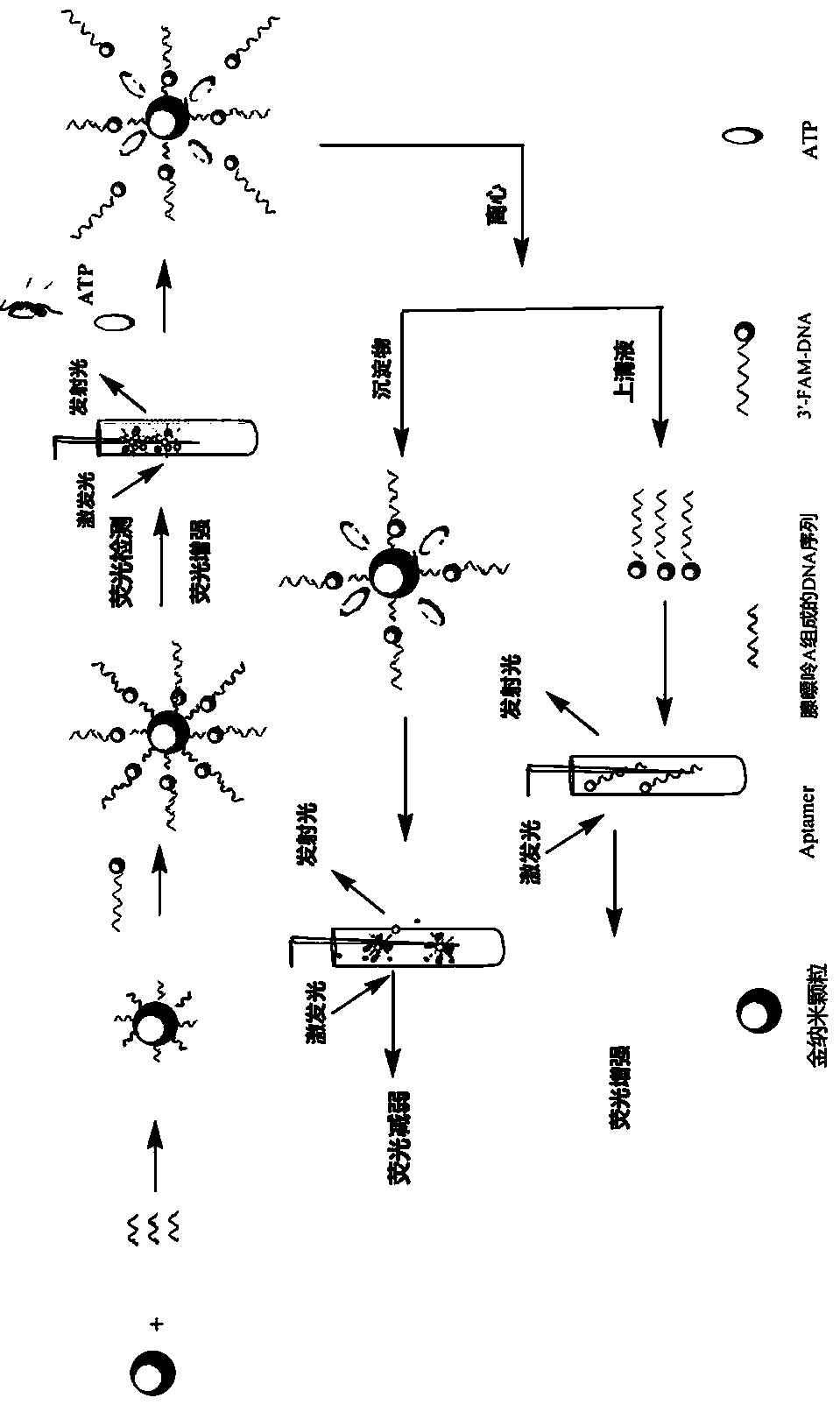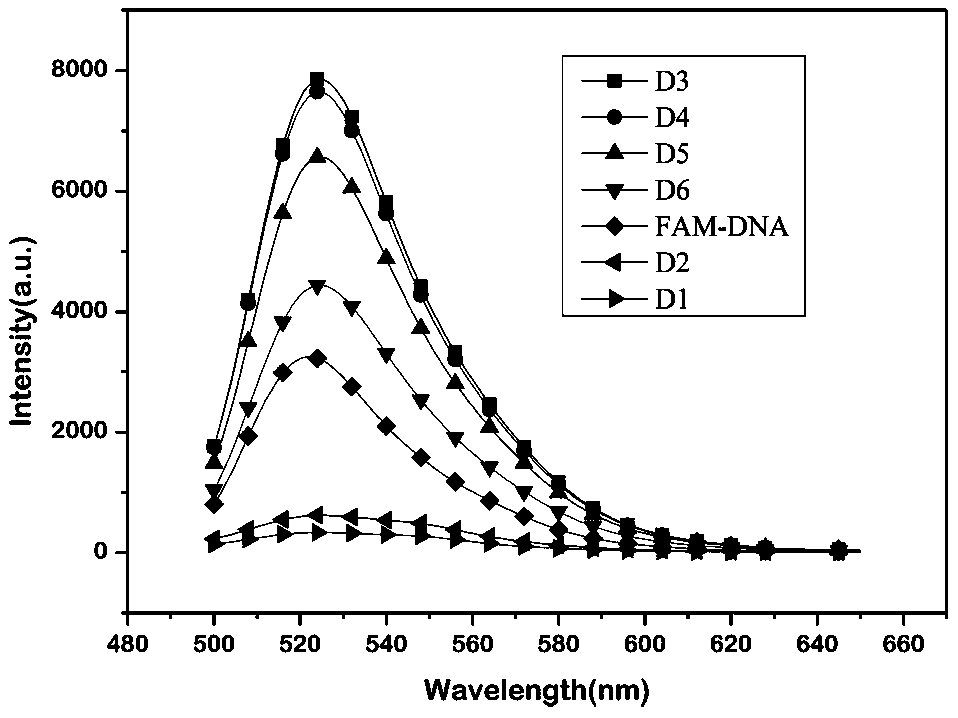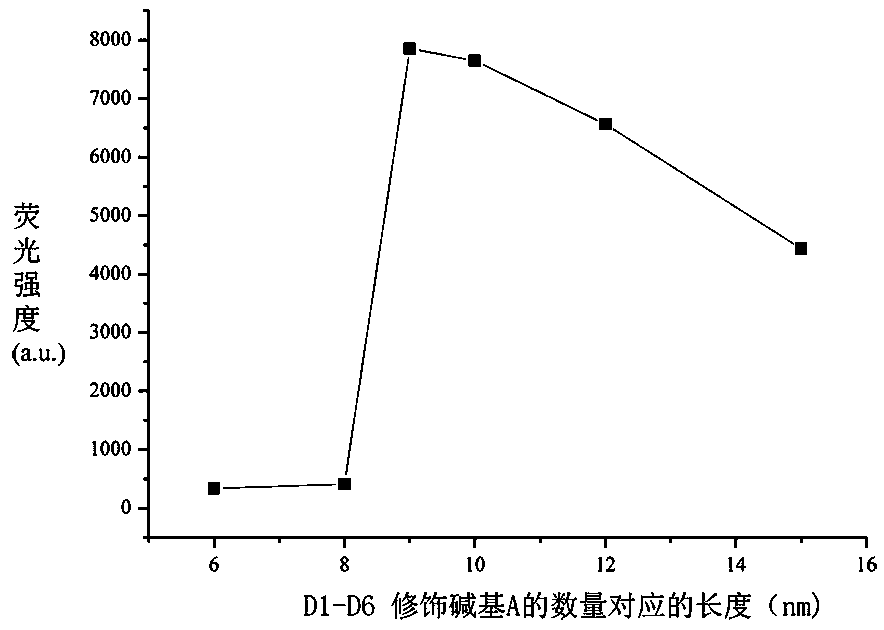Fluorescence enhanced type aptamer sensor as well as preparation method and application thereof
An aptamer sensor and fluorescence enhancement technology, applied in the field of biosensors, can solve the problems of high cost, harsh detection conditions, and high operational requirements, and achieve the effects of increased fluorescence radiation amplitude, high biocompatibility, and wide detection range.
- Summary
- Abstract
- Description
- Claims
- Application Information
AI Technical Summary
Problems solved by technology
Method used
Image
Examples
Embodiment 1
[0054] The detection of the optimal distance between embodiment 1 fluorophore and gold nanoparticle
[0055] In this embodiment, the preparation experiments of fluorescence-enhanced aptasensors are divided into 6 groups according to the difference in the distance between the fluorescent group and the gold nanoparticles.
[0056] The ATP nucleic acid aptamer used in group 1 is ATP nucleic acid aptamer 1, namely D1;
[0057] The ATP nucleic acid aptamer used in group 2 is ATP nucleic acid aptamer 1, namely D2;
[0058] The ATP nucleic acid aptamer used in group 3 is ATP nucleic acid aptamer 1, namely D3;
[0059] The ATP nucleic acid aptamer used in group 4 is ATP nucleic acid aptamer 1, namely D4;
[0060] The ATP nucleic acid aptamer used in group 5 is ATP nucleic acid aptamer 1, namely D5;
[0061] The ATP nucleic acid aptamer used in group 6 is ATP nucleic acid aptamer 1, namely D6.
[0062] The preparation of each group of fluorescence-enhanced aptasensors comprises the...
Embodiment 2
[0071] Example 2 The optimal volume ratio experiment of gold nanoparticle solution and ATP nucleic acid aptamer
[0072] In this example, according to the volume ratio of the gold nanoparticle solution (AuNPs) and the ATP nucleic acid aptamer, the fluorescence-enhanced aptamer sensor preparation experiment was divided into 4 groups, and each group used D1-D6 as the target nucleic acid aptamer .
[0073] In group 1, the volume ratio of gold nanoparticle solution (AuNPs) and ATP nucleic acid aptamer is 5:1;
[0074] In group 2, the volume ratio of gold nanoparticle solution (AuNPs) and ATP nucleic acid aptamer is 8:1;
[0075] In group 3, the volume ratio of gold nanoparticles solution (AuNPs) and ATP nucleic acid aptamer was 10:1,
[0076] In group 4, the volume ratio of gold nanoparticles solution (AuNPs) and ATP nucleic acid aptamer was 12:1.
[0077] The preparation of each group of fluorescence-enhanced aptasensors includes the following steps:
[0078] Step 1: Centrifu...
Embodiment 3
[0093] 1) Preparation of fluorescence-enhanced aptasensor, comprising the following steps:
[0094] Step 1: Centrifuge the ATP aptamer D3 at 12000 rpm for 1 min, then dilute it to 5 μmol / L with TCEP, and activate it for 2 h at room temperature in the dark without light; mix 800 μL of gold nanoparticle solution (AuNPs) and 100 μL of ATP aptamer D3 was mixed and incubated for 18h.
[0095] Step 2: Add 100 μL of 1×PBS to the solution obtained in step 1, and react for 6 hours. The function of 1×PBS is to adjust the pH value and increase the ionic strength of the solution.
[0096] Step 3: Add 2 mol / L NaCl solution to the solution obtained in Step 2, repeat every 3 hours, repeat 2 times, so that the concentration of NaCl in the total solution can gradually increase to 0.2 mol / L, and let it stand for 24 hours.
[0097] Step 4: Centrifuge the solution obtained in step 3 at 14°C and 15,000 rpm for 15 minutes, centrifuge three times in total; remove the supernatant, dissolve the obtai...
PUM
| Property | Measurement | Unit |
|---|---|---|
| length | aaaaa | aaaaa |
| length | aaaaa | aaaaa |
Abstract
Description
Claims
Application Information
 Login to View More
Login to View More - R&D
- Intellectual Property
- Life Sciences
- Materials
- Tech Scout
- Unparalleled Data Quality
- Higher Quality Content
- 60% Fewer Hallucinations
Browse by: Latest US Patents, China's latest patents, Technical Efficacy Thesaurus, Application Domain, Technology Topic, Popular Technical Reports.
© 2025 PatSnap. All rights reserved.Legal|Privacy policy|Modern Slavery Act Transparency Statement|Sitemap|About US| Contact US: help@patsnap.com



